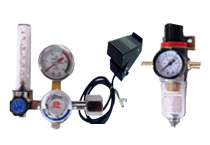
Adjusting MIGs to Run Correctly
Adjusting a MIG is usually a go or no go process on many brands of welders with fixed voltage and wire speed adjustments. It's either going to weld or it won't. Some welders because of their limited adjustment will not allow the welder to weld out of range. However, on the other side of that, is the problem of giving too little adjustment and not being able to fine tune to the arc for best operation. Everlast MIGs feature fully adjustable volt and wire speed controls, with no limits for either one. Often times people look for a printed chart to help them set up a welder properly. With the Everlast, since adjustments are infinite, it's not so easy to give a set it and forget it adjustment.
A little knowledge is needed to find the basic setting required for each wire size, and metal thickness. As a general rule, the best way to determine if a welder is operating properly is to listen for a sound that sounds somewhere between bacon frying, and an low pitched mosquito sound. Always adjust the voltage first, then adjust the wire feed to fine tune the speed to get that perfect sound. Also, when the sound is right, you can see a change in the puddle and in the wire burn back. The stickout will be right on top of the weld puddle, and not burning straight from torch electrode. But it should not be pushing you off from the weld after it starts. It should be melting nicely and the metal flowing out away from the center of the arc.
Gas flow is important as well. Finding the right flow is fairly simple, but you need to err in favor of too much gas flow, instead of too little. To adjust the gas flow, simply turn the gas flow down, until you see slight signs of bubbling and oxidation in the weld. Then, turn it back up until it completely disappears. This will be the correct gas flow rate for your weld. However, once you reach the minimum gas flow, be sure to add just a slight bit more to ensure proper gas coverage for any slight draft that may come along. If you see transient issues with bubbling in the weld, or sooty looking welds with a lot of spatter, you might want to consider adding a little more gas still.
If you are outside, the gas flow rate can be almost double the inside flow rate for similar welding conditions. Always periodically check your gas flow to make sure that it is holding correctly, and not floating up too high, or dropping off too low as the pressure in the tank drops. Ordinarily, good quality regulators will keep the correct flow, but sometimes if the tanks are being depleted rapidly, regulators with high CO2 content can freeze up or become sluggish. Ideally, when outside, try to shield the weld from as much breeze as possible with either a drop cloth to block the wind, or simply turning the weld and adjusting your body to be a wind block.






